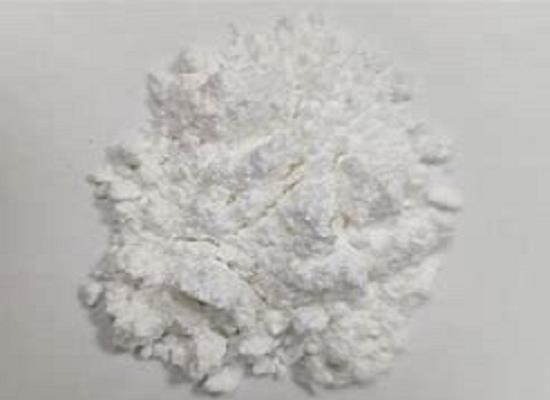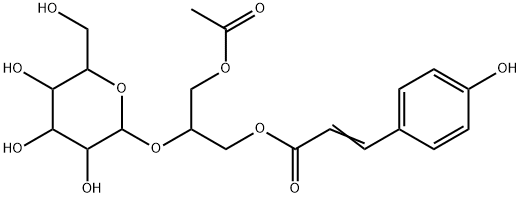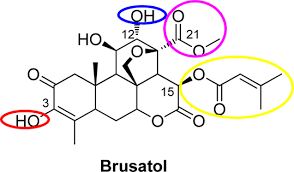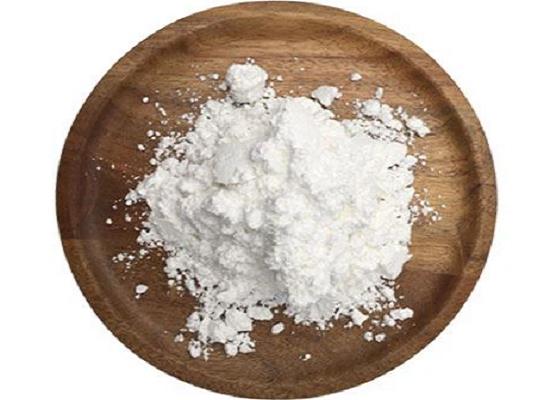Brusatol: mechanism of action and activities
General Description
Brusatol exhibits potent anticancer effects through multiple mechanisms, including inducing cell cycle arrest at different phases, promoting apoptosis via mitochondrial and death receptor pathways, and inhibiting cell proliferation by targeting various pathways such as Nrf2, PI3K/AKT, STAT3, and RhoA/ROCK1. It demonstrates multifunctional antitumor activities across various cancers, effectively inhibiting tumor cells, reducing chemoresistance, and enhancing the effects of traditional anticancer therapies. Additionally, brusatol serves as a potent inhibitor of Nrf2, affecting its protein levels, downstream gene expression, and targeting other proteins involved in cancer progression. Overall, brusatol presents a promising candidate for further exploration in cancer treatment due to its diverse and comprehensive impact on cancer cells.

Figure 1. Brusatol
Mechanism of action
Brusatol demonstrates anticancer effects through multiple mechanisms across various types of cancer. Firstly, it induces cell cycle arrest at different phases by regulating various proteins. This includes inducing subG1 phase arrest by inhibiting the PI3K/AKT/GSK3/mTOR pathway, G1 phase arrest in leukemic and melanoma cells, and S phase arrest in other cells. Additionally, brusatol can induce apoptosis through the mitochondrial pathway and death receptor pathway, as evidenced by increased expression of pro-apoptotic proteins and decreased expression of anti-apoptotic proteins. Moreover, it inhibits cell proliferation by targeting pathways such as Nrf2, PI3K/AKT, STAT3, and RhoA/ROCK1, leading to reduced cell viability and proliferative capacity. These findings highlight the diverse and comprehensive impact of brusatol on cancer cells, making it a promising candidate for further exploration in cancer treatment across different types of malignancies. 1
Activities
Antitumor activities
Brusatol has demonstrated multifunctional antitumor activities in various cancers. In vitro studies have utilized different cancer cell models, including CRC, HCC, NSCLC, pancreatic cancer, breast cancer, leukemia, and glioma. Brusatol effectively inhibits tumor cells by suppressing cell proliferation and metastasis, inducing cell cycle arrest and apoptosis, particularly in hematologic malignancies. It also enhances the effects of chemotherapy, radiation therapy, and phototherapy. Moreover, brusatol reduces chemoresistance and increases sensitivity to traditional anticancer drugs. In vivo studies have primarily employed xenograft models, with subcutaneous or tail vein injection of cancer cells in mice. Brusatol administration via intraperitoneal or intravenous routes at 0.5-4 mg/kg effectively inhibits tumor growth and metastasis by modulating various pathways. Synergistic effects have been observed when combining brusatol with other chemotherapy agents. Importantly, brusatol does not cause significant toxic side effects in vivo, as indicated by stable body weight and normal feed and water consumption in the mice. Overall, Brusatol exhibits potent antitumor effects both in vitro and in vivo, making it a promising candidate for cancer therapy. 2
Inhibitor of Nrf2
Brusatol is a potent inhibitor of Nrf2, a regulator of antioxidant and anti-inflammatory responses. Nrf2 activation contributes to tumor progression, drug resistance, metastasis, and cell proliferation. Numerous studies have shown that combining chemo-agents with Nrf2 inhibitors restrains tumor growth significantly. Brusatol inhibits Nrf2 through various mechanisms. It decreases Nrf2 protein levels by inhibiting its translation and synthesis. It also promotes Nrf2 protein ubiquitination and degradation. Brusatol inhibits the expression of Nrf2 downstream genes, including HO-1, NQO1, VEGF, and AKR1C1. In cancer cells, brusatol reduces the protein levels of Nrf2 target genes such as γGCS, MRP1, and MRP2. It also diminishes the protein expression of NQO1, GCLM, and HO-1. Additionally, brusatol regulates Nrf2 downstream genes at the transcriptional level, decreasing their mRNA and protein levels. Furthermore, brusatol targets other proteins in cancer cells. It directly targets PI3Kγ, a isoform of phosphoinositide 3-kinase, and suppresses the Skp2-Skp1-Cul1-F-box protein (SCF) E3 ligase, which promotes targeted degradation of regulatory proteins. These interactions indirectly inhibit Nrf2 pathway by regulating the PI3K/AKT signaling pathway. Overall, brusatol's activities involve inhibiting Nrf2, reducing downstream gene expression, and targeting other proteins involved in cancer progression. Its potential as an anticancer therapeutic agent has been demonstrated in multiple studies. 3
Reference
1. Yu XQ, Shang XY, Huang XX, Yao GD, Song SJ. Brusatol: A potential anti-tumor quassinoid from Brucea javanica. Chin Herb Med. 2020 Aug 19;12(4):359-366.
2. Kannan S, Irwin ME, Herbrich SM, Cheng T, Patterson LL, Aitken MJL, Bhalla K, You MJ, Konopleva M, Zweidler-McKay PA, Chandra J. Targeting the NRF2/HO-1 Antioxidant Pathway in FLT3-ITD-Positive AML Enhances Therapy Efficacy. Antioxidants (Basel). 2022 Apr 5;11(4):717.
3. He T, Zhou F, Su A, Zhang Y, Xing Z, Mi L, Li Z, Wu W. Brusatol: A potential sensitizing agent for cancer therapy from Brucea javanica. Biomed Pharmacother. 2023 Feb;158:114134.



